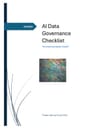What’s Covered
The guide is organized into ten core sections, each supported by checklists, quality metrics, and operational prompts:
- Strategic Alignment: Ensures AI data initiatives match the organization's broader goals.
- Leadership & Oversight: Stresses the importance of governance councils and executive accountability.
- Architecture & Infrastructure: Assesses data cataloging, FAIR principles, lineage tools, and observability (e.g., Apache Atlas, Collibra).
- Data Quality Governance: Defines six quality dimensions (accuracy, completeness, consistency, timeliness, uniqueness, relevance) with examples and monitoring metrics like drift and validation pass ratesAI Data Governance Chec….
- Security & Classification: Emphasizes RBAC/ABAC enforcement and PII masking/encryption.
- Ethics & Compliance: Covers ethics board reviews, regulatory alignment (e.g., GDPR, ISO 27001), and automated compliance checks.
- Stewardship & Lineage: Assigns clear RACI responsibilities and auditability via immutable logs.
- Risk Management: Introduces centralized risk registers and incident readiness tied to AI breaches.
- Model Transparency: Encourages the use of Data Sheets, Model Cards, and data traceability protocols.
- Continuous Improvement: Advocates for policy refresh every six months and active lifecycle monitoring.
A final section gives maturity markers (Levels 1–5), enabling orgs to self-assess progress from “Ad Hoc” to “Adaptive” governance.
💡 Why It Matters
Data governance is increasingly the linchpin of responsible AI. This guide stands out for its:
- Modular usability: Teams can adopt it incrementally or apply it end-to-end.
- Operational clarity: Translates regulatory expectations into measurable steps (e.g., ≥95% completeness before training).
- Implementation-readiness: Provides concrete tools, from SHAP/LIME for transparency to Talend for ETL.
Its framing acknowledges that even the best models fail if data governance is neglected, especially in areas like provenance, bias mitigation, or lifecycle drift. The inclusion of practical questionnaire deployment guidance helps teams turn governance theory into real-world practiceAI Data Governance Chec….
What’s Missing
- Sector-specific examples: While generalist, it could benefit from tailoring prompts for health, finance, or public sector implementations.
- More emphasis on open-source models: As many organizations rely on open models, guidance on their unique governance concerns (e.g., model retraining on open datasets) would add value.
- International scalability challenges: The focus is EU-/ISO-centric. Local compliance overlays (e.g., India’s DPDP Act, U.S. state-level laws) are not discussed.
Best For
- AI project leads preparing for model deployment
- Risk, compliance, or privacy teams aligning with ISO 42001 or the EU AI Act
- Data governance leads building cross-functional policies
- Legal counsel supporting AI contracts and DPIAs
Source Details
- Title: AI Data Governance Checklist: An Implementation Guide
- Author: Morgan Signing House
- Date: June 2025
- References: Built upon ISO/IEC 42001, EU AI Act, and practical tools like SHAP/LIME, Talend, Great ExpectationsAI Data Governance Chec….
- Publisher: Morgan Signing House, with contributions referencing SSRN and Copenhagen Compliance.


